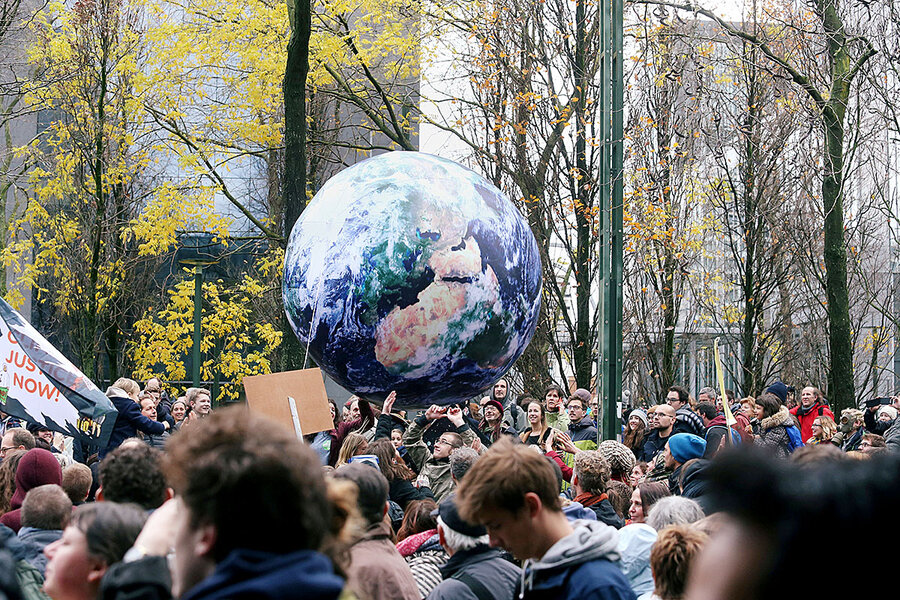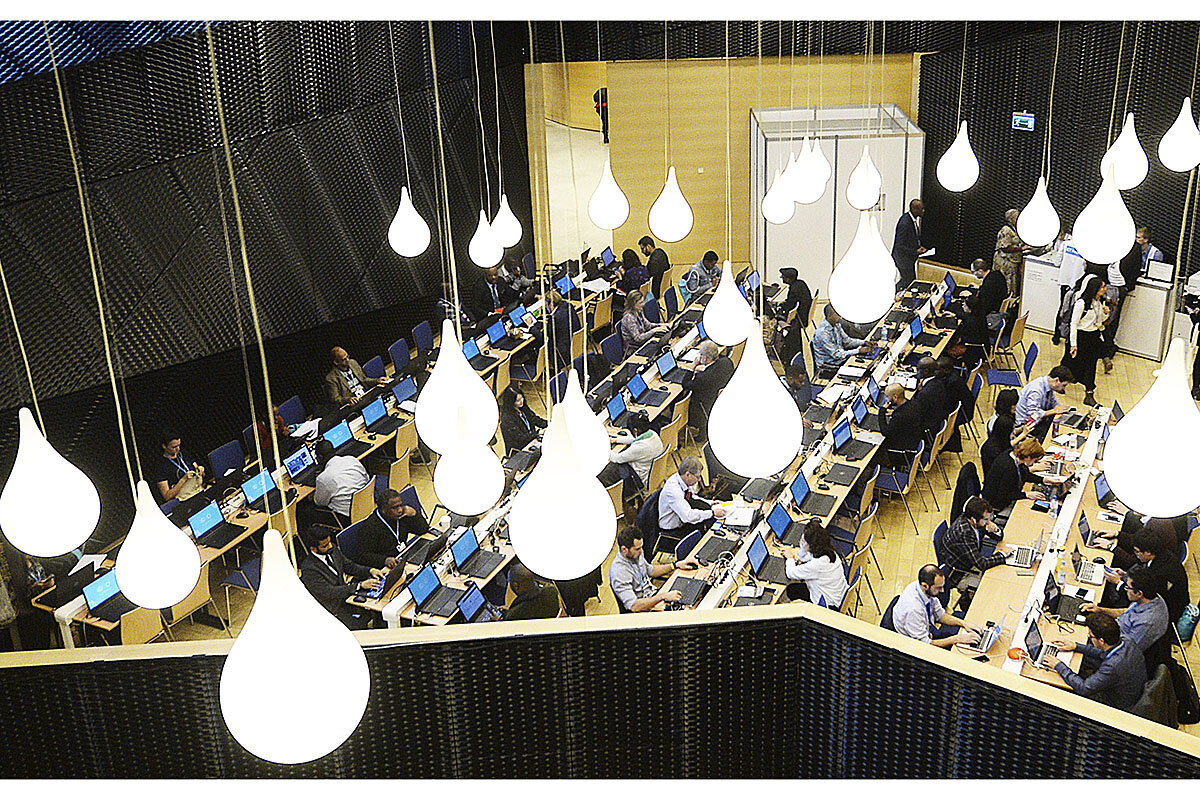At COP24, climate consensus reigns. But what does that really mean?
Loading...
| Boulder, Colo.; and Katowice, Poland
As leaders from around the world gathered in Poland for start of the United Nations’ annual climate change conference, the scientific consensus underpinning our understanding of global warming and its likely effects through the coming years and decades is a key backdrop.
The 24th Conference of the Parties to the United Nations Framework Convention on Climate Change, known as COP24, comes just a couple months after the most recent report from the UN’s Intergovernmental Panel on Climate Change, focusing on the consequences of exceeding 1.5 degrees C (2.7 degrees F.) of warming.
And just over a week ago, the US government released Volume 2 of its Fourth National Climate Assessment – a major body of work that involved input from 13 agencies and some 300 scientists, and that outlines impacts, risks, and adaptation in the United States.
Why We Wrote This
For some people, acceptance of climate change comes down to belief. But for the majority of the nations gathering for COP24, it is a matter of scientific consensus, the product of a cumulative and rigorous body of research.
Both documents represent the most authoritative and comprehensive summary of current climate science. And both paint a picture of an increasingly urgent problem.
But just what does consensus mean in a scientific sense? Some scientists worry that the public’s misunderstanding of scientific terms like “consensus,” “theory,” and “uncertainty” contributes to many misperceptions, amplifying disagreements and casting unmerited doubt.
“The word ‘consensus’ is a misleading word, because it is implying there is a negotiation about scientific outcome, and that is absolutely not true,” says Pavel Kabat, chief scientist and research director for the World Meteorological Association, as he prepares for a discussion at the UN conference hall at the “Spodek” (saucer) arena, an iconic landmark of Katowice and one of the most recognized architectural objects in Poland.
Science doesn’t negotiate, Dr. Kabat notes. Instead, the process that goes into creating something like the IPCC report he thinks can be better understood as a “synthesis of the state of the knowledge.”
When the US government released the latest National Climate Assessment on Nov. 23, a day after Thanksgiving, skeptics jumped on it, claiming it overplayed scientific certainty, relied on imperfect models, or was “based on the most extreme model scenario,” as White House press secretary Sarah Huckabee Sanders put it.
President Trump’s response to the report – which is mandated by law – was even more succinct: “I don’t believe it,” he told reporters a few days after it was released.
And this week, even as the world’s largest climate forum kicked off, Trump formalized his withdrawal from the international political consensus, making the US the only country at the Group of 20 summit of the world’s industrialized economies in Argentina not to sign a joint statement on climate change until a special clause was added reaffirming the US plan to withdraw from the Paris climate agreement.
But that sort of rhetoric, say scientists, contributes to widespread misunderstanding about just how certain scientists are.
“I think part of people’s discomfort with this is that they think it’s the same as, you know, ‘scientists say coffee is good for you; scientists say coffee is bad for you; scientists say this, scientists say that,’ ” says Katharine Hayhoe, director of the Climate Science Center at Texas Tech University and the lead author of Chapter 2 in the assessment.
While there’s always something new to learn about complex atmospheric and climate processes, says Dr. Hayhoe, the fundamental principles behind global warming are both basic and well understood.
“That science is so old and so basic that to deny that science, we would have to be denying basic thermodynamics that explains how our refrigerators and our stoves work and basic nonlinear fluid dynamics that explains how airplanes fly,” she says. “And there’s not a lot of politicians and pundits claiming that airplanes don’t fly or that stoves don’t heat and refrigerators don’t cool.”
Getting to consensus
Hayhoe and other scientists involved in state-of-the-science reports describe a process that involves hundreds of scientists, multiple reviews, public comments, and total transparency. For the most recent volume of the National Climate Assessment, each of the 29 chapters had lead writers and contributing writers – all experts in their field – who made sure they felt comfortable with everything in the chapter. In addition to comments from all authors and multiple federal agencies, the draft went through extensive public review and review by the National Academy of Sciences. Anyone from the public was invited to download and comment on the draft, and authors had to respond to every single comment on the record.
“How much more transparent can you get?” asks Hayhoe.
Indeed, rather than feeling like they’re stretching the boundaries of what scientists feel confident about, or looking at “most extreme model” scenarios, many scientists worry that these reports often downplay the risks or are too conservative.
Donald Wuebbles, an atmospheric scientist at the University of Illinois who was the lead author of Volume 1 of the latest US climate report, released last year, notes that in some instances authors of that report scaled back proposed statements to accommodate the views of more temperate scientists.
“One of the things that happens here is that, because you really want to reach a consensus, these reports tend to be very conservative,” says Dr. Wuebbles. “So when we make a strong statement – when we say it’s ‘very likely,’ greater than 95 percent certainty, that something is happening – my God, that pretty much says it’s happening.”
And, as with “consensus,” Wuebbles and others note that the public doesn't necessarily understand what “uncertainty” means in scientific terms. In science, it’s a quantifiable measurement of data variability, and is always present to some extent.
“We use models all the time for developing cars and airplanes and all kinds of other things on our planet, and those models aren’t exact either. They have uncertainties in them,” says Wuebbles.
A ‘lively process’
Some critics of big reports like those from the IPCC or the national assessments have charged that they end up being a sort of “groupthink” process where dissenting voices get filtered out. It’s a claim that the scientists most intimately involved push back against strongly.
“It’s a very lively process. It’s really hard for scientists to agree,” says Valerie Masson-Delmotte, research director at the French Alternative Energies and Atomic Energy Commission, speaking near the IPCC pavilion in Katowice. Dr. Masson-Delmotte has contributed to several IPCC reports, and says she often encounters misperceptions about the process: that scientists vote on the findings, for instance, or that they “count papers that agree or disagree.”
Scientists tend to approach the process with critical minds, she says, and with a lot of discussion about potential knowledge gaps or limits to knowledge. And diversity – of scientific background, and country of origin, and age – can make the process even more robust.
“It makes it better when you don’t work in silos,” says Masson-Delmotte. “The outcome is much more rigorous when you have more diversity in the chapter teams.”
Of course, none of this means that climate science – or any science – is “settled.” While big reports emphasize what is known, and where scientists agree, most scientists spend the bulk of their time working on what is unknown, and where they don’t agree. There are plenty of uncertainties with climate change, particularly when it comes to economic costs, localized effects, or the connection to weather events. The big synthesis reports try to make those uncertainties as clear as possible.
And each new iteration of these reports adds to and revises previous analyses, as modeling gets stronger and data and observations are added.
Looking at the changes in sea level predictions from the first IPCC report to the fifth is one example, says Masson-Delmotte. “You can see how satellite measurements have changed the way we look at ice sheets.” Satellite observations, she says, showed fast-flowing ice streams that altered scientists’ previous ideas. “Because you have new observations, you understand better the formation of ice,” she explains. “It’s not yet fully completely understood and modeled, but it changed the way people see ice sheets completely.”
Acknowledging mistakes
Sometimes, scientists do get things wrong. A major paper published in Nature this fall that indicated oceans were warming faster than scientists had believed made news both when it was published, and then when an independent researcher discovered errors in the study that made the conclusions seem more certain than they were.
The report’s authors acknowledged the errors, apologized, and are working to correct them; though they emphasize that they “do not invalidate the study’s methodology.”
It was a mistake jumped on by many skeptics, but “it’s very much part of the scientific process,” notes Wuebbles, adding that outlier results are never enough to change what the state of the science is.
Hayhoe also notes that she sees some irony in the fact that, several years ago, she was a co-author on a study that closely examined 38 contrarian papers that disputed anthropogenic warming.
“We found every single one of those studies had an error in them ... that if it was corrected brought their results in line with the scientific consensus,” says Hayhoe. And yet, she says it was hard to get any interest in study, because people said “it’s not new science.”
In some ways, the process of assembling big, state-of-the-science consensus reports is the opposite of what most scientists do in their regular work, trying to generate new knowledge. But scientists say that process of laying out consensus is still critically important, especially for policymakers. The international assessments on stratospheric ozone were a key piece of getting the Montreal Protocol passed in 1987, says Wuebbles, citing an agreement that is widely credited with shifting the tide of ozone depletion.
And with something that has become deeply politicized, like climate change, Hayhoe emphasizes that most skeptics don’t try to refute accepted facts so much as sow disinformation about the level of uncertainty.
“They understand that they don’t have to convince people that [climate change] isn’t real. All they have to do is convince people that we don’t know, and that is sufficient to delay action,” she says. As a result, she says scientists need to shift how they communicate with the public, focusing about 90 percent of their communication on what they know. “We know it’s real. We know it’s us. We know the impacts are serious and even dangerous. We know our choices matter. And what we don’t know is the potential unpleasant surprises that may result from our inadvertent but unprecedented experiment with the only home that we have.”
This story was produced with support from an Energy Foundation grant to cover the environment.






